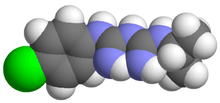- Proguanil
-
Proguanil 

Systematic (IUPAC) name 1-(4-chlorophenyl)-2-(N'-propan-2-ylcarbamimidoyl) guanidine Clinical data AHFS/Drugs.com Micromedex Detailed Consumer Information Pregnancy cat. ? Legal status ? Routes Oral Pharmacokinetic data Half-life ~20 h Identifiers CAS number 500-92-5 
ATC code P01BB01 PubChem CID 4923 DrugBank APRD00188 ChemSpider 4754 
UNII S61K3P7B2V 
KEGG D08428 
ChEBI CHEBI:8455 
ChEMBL CHEMBL1377 
Chemical data Formula C11H16ClN5 Mol. mass 253.731 g/mol SMILES eMolecules & PubChem  (what is this?) (verify)
(what is this?) (verify)Proguanil (chlorguanide, chloroguanide) is a prophylactic antimalarial drug.
Proguanil is effective against sporozoites.
Proguanil hydrochloride is marketed as Paludrine by AstraZeneca.
Contents
Mechanism
It works by stopping the malaria parasite, Plasmodium falciparum and Plasmodium vivax, from reproducing once it is in the red blood cells.
It does this by inhibiting the enzyme dihydrofolate reductase, which catalyzes the formation of tetrahydrofolate, the main one carbon unit carrier in our body, required for dTMP and purine base synthesis.
Combinations
Proguanil is usually taken in combination with another anti-malarial drug such as atovaquone[1] (e.g., in the drug Malarone) or chloroquine.[2]
Malarone has fewer side effects than mefloquine, but can be more expensive because it is taken daily.
Proguanil is taken with atovaquone for chloroquine-resistant and multidrug resistant strains of P. falciparum and P. vivax. Proguanil combined with atovaquone is sold under the tradename Malarone (GlaxoSmithKline)
Precautions
General precaution regarding Proguanil involves watching out for feelings of sullenness and anxiety to a level that is outside the ordinary, when taking over a period of several months.[citation needed] These may come on gradually and may not be immediately attributable to anything in particular.
References
- ^ Sutherland CJ, Laundy M, Price N, et al. (November 2008). "Mutations in the Plasmodium falciparum cytochrome b gene are associated with delayed parasite recrudescence in malaria patients treated with atovaquone-proguanill". Malar. J. 7 (1): 240. doi:10.1186/1475-2875-7-240. PMC 2640403. PMID 19021900. http://www.malariajournal.com/content/7/1/240.
- ^ Payen C, Monnin L, Pulce C, Descotes J (December 2008). "Bone marrow aplasia following acute poisoning with chloroquine-proguanil". Clin Toxicol (Phila) 46 (10): 1085–7. doi:10.1080/15563650601182925. PMID 19065311. http://www.informaworld.com/openurl?genre=article&doi=10.1080/15563650601182925&magic=pubmed%7C%7C1B69BA326FFE69C3F0A8F227DF8201D0.
External links
Antiparasitics – antiprotozoal agents – Chromalveolate antiparasitics (P01) Alveo-
lateIndividual
agentsOtherDHFR inhibitors
(antifols)Sulfadoxine • sulfamethoxypyrazineCoformulationFansidar# (sulfadoxine/pyrimethamine)OtherCombi-
nationsFixed-dose (coformulated) ACTsartemether-lumefantrine#
artesunate-amodiaquine (ASAQ)
artesunate-mefloquine (ASMQ)
dihydroartemisinin-piperaquine
artesunate-pyronaridineOther combinations
(not co-formulated)artesunate/SP • artesunate/mefloquine •
quinine/tetracycline • quinine/doxycycline • quinine/clindamycinHetero-
kont
This antiinfective drug article is a stub. You can help Wikipedia by expanding it.
